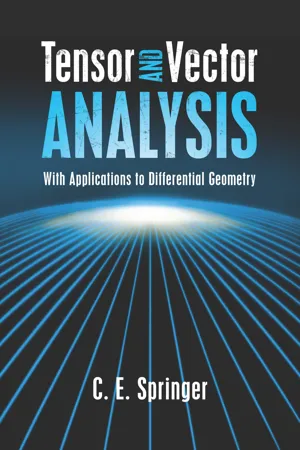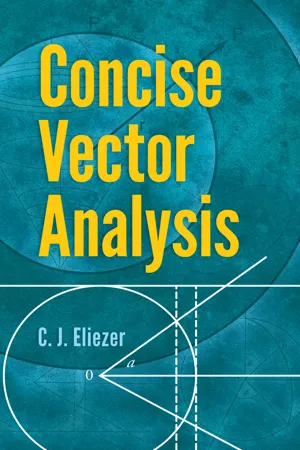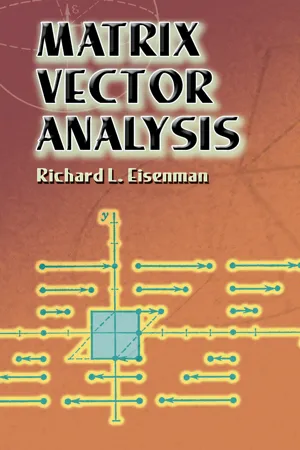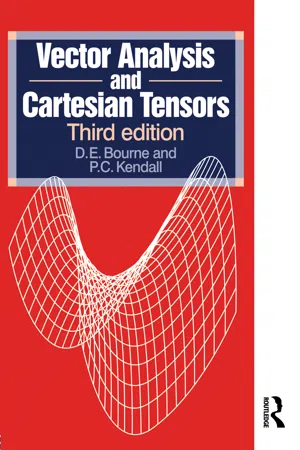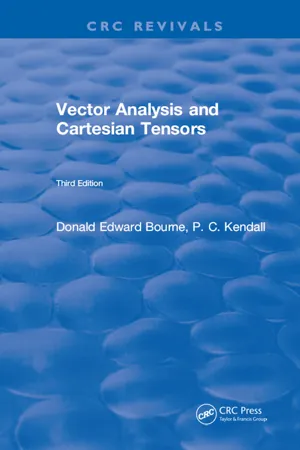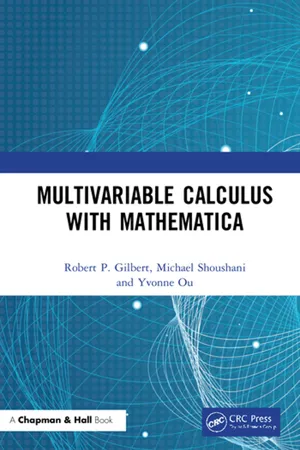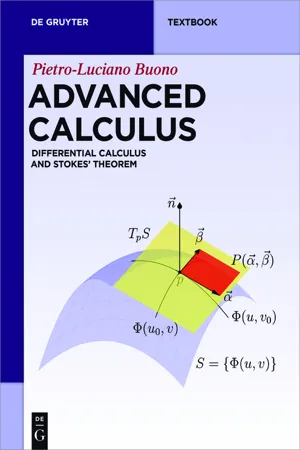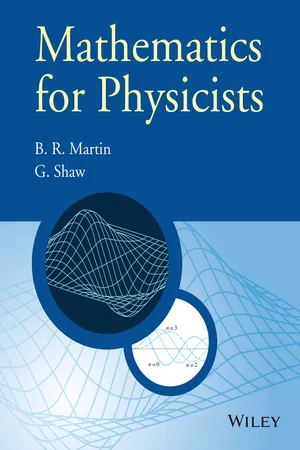Physics
Line Integral
A line integral in physics is a type of integral that is calculated along a curve or a line. It represents the cumulative effect of a vector field along the path of the curve. Line integrals are used to calculate work done by a force along a path, or to calculate the flow of a vector field through a curve.
Written by Perlego with AI-assistance
Related key terms
8 Key excerpts on "Line Integral"
- eBook - ePub
Tensor and Vector Analysis
With Applications to Differential Geometry
- C. E. Springer(Author)
- 2013(Publication Date)
- Dover Publications(Publisher)
11Integration of Vectors
11–1. Line Integrals . One may consider the integration of a tensor (scalar function, vector, dyadic, etc.) over a space (curve, surface, three-space, etc.), but attention will be restricted in this chapter to the integration of scalar functions and vectors along segments of curves, portions of surfaces, and domains of three-space. Of immediate concern is the integration of a function along a curve. This will be called a line integral.In order to make the concept of a Line Integral meaningful, it is well to begin by pointing out that the ordinary definite integralover the segment from x = a to x = b of the x -axis is a Line Integral. The meaning attached to this integral was shown in the elementary calculus to be the following: Partition the interval from a to b (Fig. 24 ) into nFig. 24subintervals, choose a pointxiin the i th subinterval, the length of which is Δxi, and form the product f (xi) Δxi. Take the sum of such products for i = 1, 2, · · · , n to obtainThe limit (if it exists) of this sum as n → ∞ and as each Δxi→ 0 in length, is evaluated by the definite integralOf course, the resulting integral may be interpreted as an area, but it need not be so interpreted. It is preferable at the moment to think of the result of the integration as a number. The result of taking the limit of the sum of the products of numbers f (is a function of the upper limit. Each of the line, surface, and volume integrals to appear below may be obtained as a limit of a sum, just as was obtained in the calculus; but for the sake of brevity, the integral notation will be used.xi) and Δxiis a number, if the limit exists. Notice that if b = x , a variable, thenFig. 25As a first attempt at generalizing the Line Integral of a function along a segment of the x -axis, proceed as follows. Integrate a function f (x ,y ) of two variables over a segment, say OA , on the x -axis, and then over the line AB parallel to the y -axis (Fig. 25 ). Note that y = 0 along OA , and x = a = constant along AB , ds = dx on OA , and ds = dy on AB - eBook - ePub
- C. J. Eliezer(Author)
- 2016(Publication Date)
- Dover Publications(Publisher)
(4) , it is determined by utilizing its connection with the indefinite integral.The integrands in Line Integrals may be scalars or vectors. Thus there are integrals of the typewhich in terms of Cartesian components may be writtenIf s denotes the arc distance P0 P of a variable point P on the curve from a fixed point P0 on the curve, the symbol ds may be used to denote the vector whose magnitude is the infinitesimal scalar element ds and whose direction is along the tangent to the curve at P. That is,whereis unit vector along the tangent at P.The scalar Une integral of a vector A over a curve C is defined asWe note thatwhere As is the component of A in the direction of the tangent to the curve at P (Fig. 2 ). In terms of Cartesian components (9) may be writtenFig. 2 A vector Line Integral may be defined in the same way, namely which in terms of Cartesian components may be writtenExample 1. Evaluatewhere C the path of integration is(a) the straight line joining A(0, 0, 0) to B (6, 8, 10);(b) the arc of the circle x2 + y2 = a2 , z = 0 in the first quadrant in the xy-plane.(a) The equation of the straight line AB is x/3 = y/4 = z/5.The coordinates of any point on the Hue may be expressed in terms of a parameter t by the equationswhere t takes values from t = 0 to t = 2.The differentials dx, dy, dz are expressed in terms of dt byHence Therefore(b) The coordinates of any point on the arc of the circle x2 + y2 = a2 , z = 0 in the first quadrant may be expressed in terms of a parameter θ wherewhere .Hence ds = a dθ.Example 2. A smooth wire in the form of the cycloidis fixed with its axis vertical and vertex 0 at the highest point. A bead of mass m free to slide along the wire under gravity, is released from rest at the point A where ψ = π/6. Find the time that the bead takes to reach the lowest point B where ψ = π - eBook - ePub
- Richard L. Eisenman(Author)
- 2013(Publication Date)
- Dover Publications(Publisher)
.3.6 | Line IntegralSEXERCISE [22]:Work out:a. , whereb. , where , and the region comprises andc. , whered. , where, where C denotes a directed curve segment, is called the Line Integral of on the curve segment C. Analytically, the Line Integral is determined when one prescribes:The explicit vector point function and the curve segment CGeometrically, the Line Integral totals the projections of the vector along incremental displacements ; in particular, the usual scalar integral , which may be represented by area, is a Line Integral on the curve segment of the x axis from a to b; arc length gives another geometric interpretation. Physically, the Line Integral may be represented as the work done by the force in the changing displacement ; the total mass of a wire gives another physical interpretation. In the theory of functions of a complex variable every integral is defined as a Line Integral.Example: , where , and C is defined by x = t, y = 2t − t2 , and z = 0 for .Thus or Every Line Integral reduces to an ordinary scalar integral.Example: Work out if anda. C1 is defined by forb. C2 is defined by forFor part , and .Then, after some expansion,Part b was much easier mechanically and produced the same result as part a. In Sec. 3.8 we shall discuss the foresight required to decide that two different curve segments will produce the same answer, dependent only upon the end points.EXERCISE [23]:Reduce each Line Integral to a scalar integral in t and compute; sketch the curve segment C and the force at several strategic points on C.Ca.b.c.d.We have seen that the data needed to reduce and work out a Line Integral may take several forms. In our examples and were given directly in terms of t; then and were given as vector point functions, always being understood as the position vector , and the curve segment was given parametrically; finally, was given as a vector point function, was understood to be the position vector, and the curve segment was prescribed by giving the position vector in terms of t. Another reasonable way to prescribe a Line Integral is to give - P C Kendall(Author)
- 2017(Publication Date)
- Routledge(Publisher)
Thus the required Line Integral is Integral around a closed curve Let be a simple closed curve of total length l. The Line Integral taken all the way round, is usually denoted by We have already shown that the Line Integral of a scalar field along a curve is independent of the sense of description of the curve. When the curve is closed, the Line Integral is also independent of the point from which arc length is measured. Proof Let P, Q be different points on a closed curve. Let s denote arc length measured from P and let s ´ denote arc length measured from Q (Fig. 5.2). Then at any point s = s ′ + constant. (5.6) Hence which proves the result stated. Fig. 5.2 EXAMPLE 2 Evaluate the Line Integral of Ω = (a 2 y 2 / b 2 + b 2 x 2 / a 2) 1 2 around the ellipse with equation x 2 / a 2 + y 2 / b 2 = 1, z = 0. Solution The parametric equations of the ellipse can be taken as x = a cos θ, y = b sin θ, z = 0, 0 ≤ θ ≤ 2 π. If s denotes arc length, we have Also,. on, Ω = (a 2 sin 2 θ + b 2 cos 2 θ) 1 2. Hence EXAMPLE 3 Evaluate the Line Integral of Ω = x 2 + y 2 around the triangle with vertices at the origin O and the points A (1, 0, 0), B (0, 1, 0)(Fig.5.3) Fig. 5.3 Solution The integral is evaluated in three parts. (a) (b) (c) The equations of AB are x + y = 1, z = 0 Hence we can take x = 1 − t, y = t, z = 0, where t is a parameter which varies from 0 at A to 1 at B. If s denotes arc length of AB Also, on AB, Ω = (1 − t) 2 + t 2. Thus Combining (a), (b), and (c) now gives Exercises 5.1 Evaluate the Line Integral along the curve with intrinsic equation r = (4 5) 1 2 (a cos (s / 2 a), a sin (s / 2 a), s). 5.2 A straight line is drawn parallel to the y -axis through the points P (1, 0, 0), Q (1, 3, 0). Show that [ Hint- eBook - ePub
Vector Analysis and Cartesian Tensors
Third Edition
- Donald Edward Bourne(Author)
- 2018(Publication Date)
- Chapman and Hall/CRC(Publisher)
Evaluate ∮ C x y d s. 5.2 Line IntegralS OF A VECTOR FIELD Scalar Line Integrals Let the vector field F (x, y, z) be defined at all points on the piecewise smooth curve C given by equation (5.1). If T ^ denotes the unit tangent to C we define I = ∫ 0 l F. T ^ d s (5.7) to be the scalar Line Integral of F along C provided, of course, that the integral exists. Since T ^ d r = d s it is usual to put T ^ d s = d r. (5.8) Thus, (5.7) becomes I = ∫ 0 l F. d r. (5.9) If C is a simple closed curve, the Line Integral around C is denoted by K = ∮ C F. d r ; (5.10) K is called the circulation of F around C. When the sense of description of a curve is reversed the direction of the unit tangent T ^ is also reversed. Thus, the scalar Line Integral of a vector field along a curve changes sign when the sense of description of the curve is changed. EXAMPLE 4 Evaluate the scalar Line Integral of F = (z, x, y) around the circle x 2 + y 2 = 0, z = 0, described in the clockwise sense relative to an observer looking along the positive z -axis. Solution The parametric equation of the circle C may be taken as r = (a cos θ, a sin θ, 0), 0 ⩽ θ ⩽ 2 π, the range of θ being chosen so that the sense of description is as. required. On C, F = (0, a cos θ, a sin θ). Also, d r d θ = (− a sin θ, a cos θ, 0). Thus, ∮ c F. d r = ∫ 0 2 π F. d r d θ d θ = ∫ 0 2 π a 2 cos 2 θ d θ = π a 2. EXAMPLE 5 Show that the circulation of any constant vector field A around any simple closed. curve C is zero. Solution Choose the x -axis parallel to A. Then A. d r = (A, 0, 0). (d x, d y, d z) = A d x. Thus ∮ C A. d r = A ∮ C d x. If P 1, P 2 are points on C corresponding to x = x 1, x = x 2 respectively, then integrating along C, ∫ P 1 P 2 d x = x 2 − x 1. Allowing the - eBook - ePub
- Robert P. Gilbert, Michael Shoushani, Yvonne Ou(Authors)
- 2020(Publication Date)
- Chapman and Hall/CRC(Publisher)
C, denoted(6.14)here ϕ stands for a closed Line Integral. We assume that C is simple, i.e. it does not intersect itself (except for the endpoints B = E). Let P be any point on C which is different from B. We compute (6.14 ) by breaking C into two curves, C1 from B to P, and C2 from P to E = B,(6.15)If the force field F is conservative, then all closed Line Integrals are zero,(6.16)representing the fact that the net work of returning to the same point is zero.Example 6.4. If a Line Integral is known to be path-independent, we can sometimes simplify its computation. For example, consider the inverse–square force(6.17)so called because it is inversely proportional to the square of the distance ‖r‖ from the origin, indeedThe work from B := (1, 0, 0) to E := (2, 1, 1), along the path given parametrically byis the Line Integralwhich is a difficult integral, however not for MATHEMATICA , as may be seen in the next session. However, the force (6.34 ) is conservative (we show this in Example 6.12), so the above Line Integral is independent of the path C. We can therefore integrate along a simpler path from B to E. The simplest such path is the straight lineThen the integral simplifies toExample 6.5 (Circulation). Let v be the velocity field of a fluid, i.e. at any point r = <x,y,z>, the vector v(x, y, z) is the velocity of the fluid at that point. Let C be a simple closed curve. The circulation (of the fluid) around the curve C is defined as the closed Line Integral(6.18)where α corresponds to an arbitrary parameterization of the closed curve C - eBook - ePub
- Pietro-Luciano Buono(Author)
- 2016(Publication Date)
- De Gruyter(Publisher)
4Line Integrals
We introduce the concept of Line Integrals starting with the integration of 1-forms. This leads to the first of the important theorems of Vector Calculus: the Fundamental Theorem of Line Integrals which is a generalization of the Fundamental Theorem of Calculus seen in elementary calculus courses. We then extend these results to the context of vector fields.4.1Integration of 1 forms
When introducing differentials, we mention that expressions such as dt , dx , dy need to satisfy conditions (1), (2), (3) at the beginning of Section 3.2. The first two are satisfied with the definition given above and we even generalized to higher dimension. We now look at condition (3) which has to do with integration. However as the previous section shows, the concept of 1-forms is more general (at least in dimensions greater than 1) and so we define what it means to integrate 1-forms.4.1.1Revisiting integration in one-dimension
We can now properly define integration, not of functions, but of 1-forms over “space curves” in ℝ. This is done using Riemann sums as in elementary calculus.Fig. 4.1. Curve C is the interval [a, b ] with partition a = t 0 < t 1 < … < tn-1 < tn = b and vectors vj , j = 0, . . . , n − 1.Let C be the positively oriented curve given by the interval [a, b ] ⊂ ℝ, with parametrization r (t ) = t , t ∈ [a, b ]. Let ω = f (t ) dt be a continuous 1-form defined over C .We begin by defining a partition of [a, b ]:At each pointtjof the partition, define vectors in the tangent spaceand writevj= Δtj e1 where Δtj=tj+1 −tj. Now, evaluate ω at eachtjonvj:and take the sum over all j = 0, . . . , n − 1. Therefore,By noticing that dt (vj) = Δtj, (4.1) is just a Riemann sum used to define the integral as it is shown in elementary calculus. Adding points to the partition so that every subinterval [tj− 1, tj - eBook - ePub
- Brian R. Martin, Graham Shaw(Authors)
- 2015(Publication Date)
- Wiley(Publisher)
12 Vector calculusIn Chapter 8 we introduced the idea of a vector as a quantity with both magnitude and direction and we discussed vector algebra, particularly as applied to analytical geometry, and the differentiation and integration of vectors with respect to a scalar parameter. In this chapter we extend our discussion to include directional derivatives and integration over variables that are themselves vectors. This topic is called vector calculus or vector analysis. It plays a central role in many areas of physics, including fluid mechanics, electromagnetism and potential theory.12.1 Scalar and vector fields
If scalars and vectors can be defined as continuous functions of position throughout a region of space, they are referred to as fields and the region of space in which they are defined is called a domain. An example of a scalar field would be the distribution of temperature T within a fluid. At each point the temperature is represented by a scalar field T(r) whose value depends on the position r at which it is measured. A useful concept when discussing scalar fields is that of an equipotential surface, that is, a surface joining points of equal value. This is somewhat analogous to the contour lines on a two-dimensional map, which join points of equal height. An example of a vector field is the distribution of velocity v(r) in a fluid. At every point r, the velocity is represented by a vector of definite magnitude and direction, both of which can change continuously throughout the domain. In this case, we can define flow lines such that the tangent to a flow line at any point gives the direction of the vector at that point. Flow lines cannot intersect. This is illustrated in Figure 12.1 .Figure 12.1The motion of a fluid around a smooth solid. The coloured lines are the flow lines and the arrows show the direction of the vector field, in this case the velocity v(r
Learn about this page
Index pages curate the most relevant extracts from our library of academic textbooks. They’ve been created using an in-house natural language model (NLM), each adding context and meaning to key research topics.
